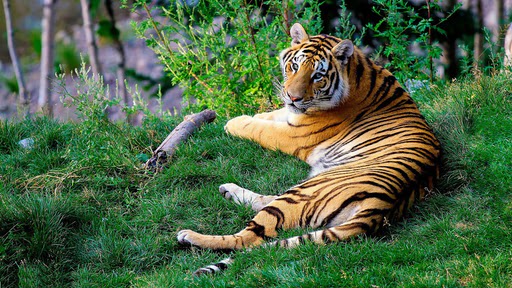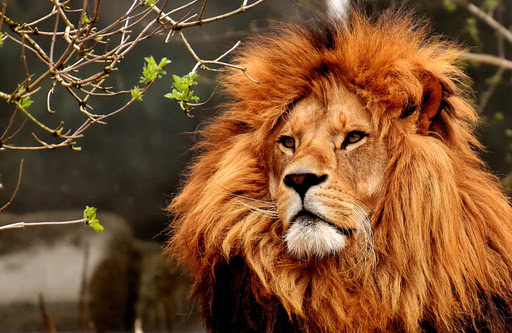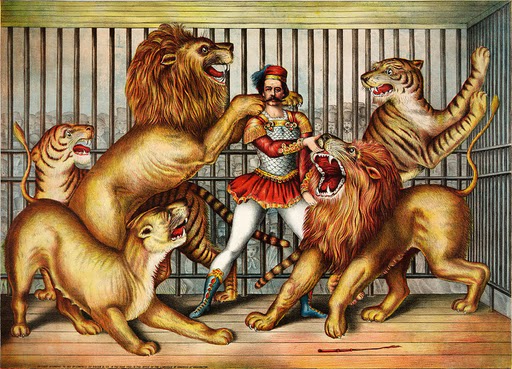The result of a fight between a lion and a tiger would depend on various factors such as their age, breed, mood, fighting style, and physiology. However, historical evidence suggests that tigers are slightly more likely to emerge victorious in the duel.
If I were to ask you who is the ruler of the jungle, what would your answer be? “Lion,” you would confidently reply. Well, that’s what we have all been taught since childhood – the lion is the king of the jungle.
 However, is the lion truly the undisputed king of the jungle? (Photo Credit: Pixabay)
However, is the lion truly the undisputed king of the jungle? (Photo Credit: Pixabay)
So, is the lion’s majesty unmatched? Are there no other contenders for such a claim over the wild kingdom? Its cousin, the tiger, is arguably more ferocious and powerful. So, who truly deserves the title of king between them? We will attempt to find answers to this question from both a historical and scientific standpoint.
When it comes to wild animals, lions and tigers are two of the most fearsome predators on the planet. They are notorious for hunting even humans. So, before we delve into the captivating rivalry between these two super cats, let’s take a closer look at them individually.
Tigers
Tigers are one of the largest land predators and generally outweigh lions. Unfortunately, the tiger population has declined over time due to relentless poaching, and they are now only found in specific tropical deciduous forests of Asia. The distinctive stripes on each tiger are unique and serve as their identification, much like our fingerprints!
 Bengal tiger (Photo Credit: Pixabay)
Bengal tiger (Photo Credit: Pixabay)
Tigers are solitary creatures that primarily hunt and live alone. They possess a robust, muscular body that is both agile and flexible. Tigers have exceptional eyesight and can see their prey even in darkness.
Another remarkable characteristic of tigers is their ability to effortlessly climb trees and swim, even in fast-flowing rivers. Tigers are known to consume fish, tortoises, and even alligators in the wild! They are skilled predators that have adapted to various ecosystems, from swimming in lakes to climbing trees. They can either hunt their prey in broad daylight or ambush their victims in the darkness.
 Tigers are skilled swimmers (Photo Credit: Pixabay)
Tigers are skilled swimmers (Photo Credit: Pixabay)
Lions
Lions are large cats that can be found in Asia and Africa. Male lions are known for their thick and majestic manes around their necks.
 Lion with a beautiful thick mane (Photo Credit: Pixabay)
Lion with a beautiful thick mane (Photo Credit: Pixabay)
Pride Of Lions
Unlike tigers, lions are social animals that live in groups called prides. A pride usually consists of one or two adult male lions, several lionesses, and their cubs. Male lions spend their lives protecting their pride from other wandering lions. Interestingly, it is the lionesses who do most of the hunting, while male lions only join in when there is a need to take down a large prey like a giraffe or a buffalo.
Lion prides demonstrate great teamwork. Each member of the pride has a role in hunting and other activities. Some chase after the prey while others surround it to prevent escape. The adult male lion’s role is often to intimidate and take down the largest prey. For example, when hunting a zebra or giraffe, a male lion would growl at the prey and steer them towards waiting lionesses.
 Lion’s pride (Photo Credit: Pixabay)
Lion’s pride (Photo Credit: Pixabay)
It’s important to note that lions are born fighters. They spend most of their lives defending their pride and fighting off any challengers. These frequent battles make male lions experienced and formidable fighters. Another intimidating aspect of lions is their powerful roar, which can be heard from miles away!
Now that you have some knowledge about these mighty cats, let’s compare them quantitatively to their fellow wild master, the tiger.
Comparison Of Lion And Tiger
- Body size: While the size of both cats varies depending on the species, a fully grown Siberian tiger can reach lengths of over 10 feet. On the other hand, an adult African lion can grow up to 9 feet in length. A mature Siberian tiger can weigh over 600 pounds, while an adult African lion typically weighs under 500 pounds. Roughly speaking, tigers are about 15-20% larger than lions.
- Bite force: Both lions and tigers have around 30 teeth, but tigers have longer and sharper fangs that can cause deeper wounds. Tiger fangs measure approximately 4 inches, while lion teeth are about three inches long. Therefore, tigers have a stronger bite force than lions.
- Brain size: Studies show that tigers have relatively larger brains compared to their body size than lions.
- Mane: Male lions have a distinctive mane around their necks. Many experts believe that this mane gives lions an advantage in battles because it protects vulnerable areas like the carotid artery and cervical vertebrae. Tigers, on the other hand, do not have a mane and are more susceptible to attacks on their necks.
Do Lions And Tigers Crossover In A Natural Habitat?
Lions and tigers generally do not coexist in the same geographical areas. However, there are places in India where lions and tigers have overlapping habitats. Unfortunately, tiger populations have significantly declined due to rampant poaching.
Colin Tudge, a well-known biologist and science writer, suggests that in the past, when there were large populations of both tigers and lions, they competed for the same prey. In an attempt to coexist, there have been efforts to bring lions and tigers together in the same habitat. For instance, during the time of British rule in India, the Maharaja of Gwalior attempted to relocate some African lions to the Kuno Palpur sanctuary in India, where tigers resided. Unfortunately, this project was not successful as some lion cubs died during the journey from Africa to India, and those that survived were later found dead. There are different theories regarding the cause of their deaths, with some suspecting that tigers killed them while others claim that the locals killed the lions because they became man-eaters after arriving.
The Indian government has proposed the Asiatic Lion Reintroduction project, aiming to reintroduce Asian lions from the Gir forest, which is facing rapid depletion, to other regions including sanctuaries where tigers live. However, this project has faced opposition from the government of Gujarat, where the Gir forest is located, as they strongly oppose the relocation of lions. One of the reasons for this opposition is the fear that tigers would attack and kill the incoming lions.
In this section, we have explored the natural interactions between lions and tigers. Now, let’s shift our focus to some well-known fights between these two cats that took place in captivity and examine the outcomes of their violent battles.
Famous Lion Vs. Tiger Fights
The battles between lions and tigers have always captured the interest of humanity, including hunters, naturalists, historians, and science writers like us!
Ancient Rome
In ancient Rome, lions and tigers were frequently matched against each other in arenas for the cruel entertainment of the spectators. To attract the attention of the common people, Roman emperors organized fights between African lions and Asian tigers in the Colosseum. Although the battles were intense, tigers usually emerged victorious and killed the lions in most cases.
Did you know that in the lion-tiger fights held in the Colosseum in ancient Rome, gamblers used to bet on the tigers? (Photo Credit: AdryPhoto1/Shutterstock)
Ferocious Gunga
One of the most famous tigers, known to have defeated around 30 lions in various encounters, was a Bengal tiger named Gunga. Gunga was owned by the Emperor of Awadh in India and was later transferred to a zoological garden in London. It is claimed that this mighty tiger could defeat a lion in just 10 minutes!
Gunga, also referred to as Nina Saheb, has a famous tale of bravery. Harper’s Weekly reported in 1859 that before one of the lion-tiger fights, the tiger had an altercation with its keeper in captivity in London. For some reason, Gunga attacked the keeper, who defended himself by injuring the tiger with a crowbar, partially blinding the ferocious beast in one eye. Following this incident, a fight was arranged, and according to legend, the tiger entered the duel partially blinded.
 An etching from the 19th century depicting lions and tigers in captivity with a keeper (Photo Credit: Gibson /Wikimedia Commons)
An etching from the 19th century depicting lions and tigers in captivity with a keeper (Photo Credit: Gibson /Wikimedia Commons)
As the fight began, the tiger launched a fierce attack on the lion, and their battle continued for some time until the tiger grew weary. Lions generally have greater endurance, and the lion took advantage of this by pouncing on Gunga. However, the legendary tiger showed incredible resilience. Lying on its back, Gunga swiftly struck back at the lion with its hind legs, tearing open the lion’s stomach. This caused the lion to bleed heavily and ultimately die.
The Triumph of a Bengal Tiger Over the Barbary Lion
Another intense event in the rivalry between lions and tigers took place in the late 19th century. Gaekwad of Baroda, the prince of a small state in colonial India, organized a fight between these two powerful cats in an amphitheater. Gaekwad had placed a significant bet on the Barbary lion, brought from the mountains of Algeria, to fight against a royal Bengal tiger.
During the fight, both cats suffered injuries. Interestingly, the tiger initially retreated from the mighty lion but later returned to resume the battle.
Despite the valor displayed by the Barbary lion during the prolonged fight with the tiger, it succumbed to the injuries inflicted by the ferocious Bengal tiger and perished. Gaekwad had to pay 37,000 rupees, which is roughly equivalent to 1 million dollars today, and accept the tiger as the true king of the feline family!

Juno the Great
So far, we have only discussed encounters where the tiger emerged as the victor, but this is not always the case. There is a tale of a courageous lion named Juno, who is said to have killed as many as 13 tigers in various encounters. It is uncertain whether Juno killed the tigers in one-on-one battles or with the assistance of other lions.
Lions hunt in packs, which gives them a clear advantage over solitary tigers. Whatever the circumstances may be, Juno was one of the most remarkable and courageous Barbary lions, a species that is now extinct but known for their toughness and bravery.
 Barbary lions, which used to have thick and dark manes, are now extinct species of lions (Photo Credit: public domain/Wikimedia Commons)
Barbary lions, which used to have thick and dark manes, are now extinct species of lions (Photo Credit: public domain/Wikimedia Commons)
Lion Vs. Tiger: Which Animal Comes Out on Top?
As previously mentioned, the outcome of a battle between a lion and a tiger is heavily influenced by various factors such as age, breed, mood, fighting style, and physiology. While experts do not unanimously agree on the winner, the general consensus leans towards tigers.
Expert Viewpoint
Alex Kerr, an animal trainer who has extensive experience with both lions and tigers, states in his book that tigers have historically emerged victorious in lion vs. tiger fights. John Varty, the owner of a private reserve in South Africa where lions dominate, also favors tigers over lions, believing that tigers are superior fighters. Experts involved in the Save China Project assert that tigers exhibit greater physical strength and that a Siberian or Bengal tiger would defeat an African lion.
However, not all experts agree with the tiger’s supremacy. Some hold the opposite view. For instance, renowned animal trainer Clyde Betty claims that a fully grown lion is more likely to triumph over a fully grown tiger. Renowned animal conservationist Kailash Sankhala, also known as The Tiger Man of India, interestingly places more trust in lions than tigers. He believes that the male lion’s mane provides a strong advantage by acting as a shield against a tiger’s brutal throat attack. Tigers lack such protection, making them more vulnerable to an assault by a lion. In his book, he observes that if a tiger of equal size were pitted against a lion, the tiger would struggle to keep up with the lion.
 Asiatic lion and Bengal tiger in Bannerghatta National Park, India (Photo Credit: Saravankm/Wikimedia Commons)
Asiatic lion and Bengal tiger in Bannerghatta National Park, India (Photo Credit: Saravankm/Wikimedia Commons)
Final Thoughts
Both lions and tigers have their own strengths and weaknesses. Tigers, for example, spend most of their lives as solitary hunters and have more muscle mass. They are larger and heavier. Additionally, they possess sharper and longer fangs and claws. Tigers are slightly faster, arguably more ferocious, and certainly more agile. They can swim and climb trees. Lions, on the other hand, are more resilient and courageous. They have experience taking down large adversaries, such as elephants or giraffes, albeit in a group. Lions also have experience battling other lions in the wild to protect their pride, which tigers lack.
Tigers are formidable predators, opting for calculated and powerful attacks on their opponents. Lions, on the other hand, first assess their opponent’s strength by striking with a single paw during duels. They usually take more time before going all out. This may be because they typically have other lions as backup in the wild. Tigers are impulsive attackers, always eager to go all in from the start. Evolution may have conditioned them to be more ferocious and rely on swift kills. However, this approach can backfire if a tiger expends energy too quickly and encounters a resilient lion, making the tiger vulnerable to defeat.
While the ultimate winner is unclear, tigers are strong contenders for the title of King of the Jungle, a distinction typically associated with lions!
